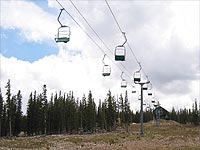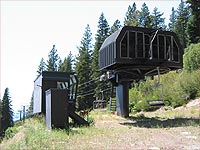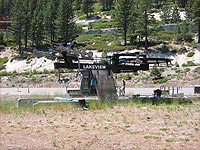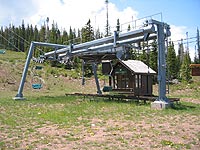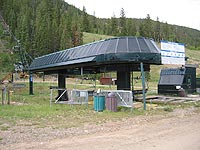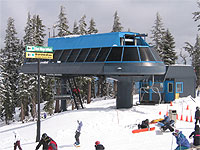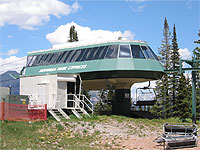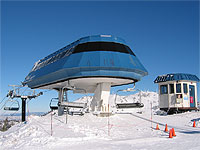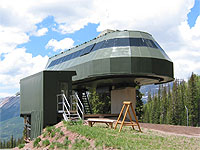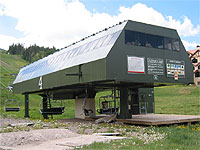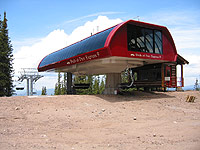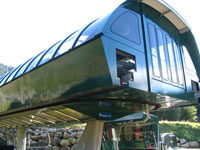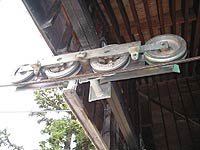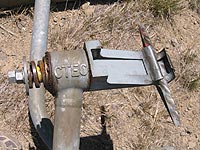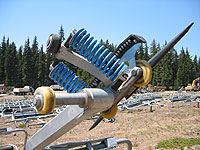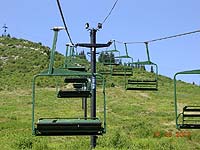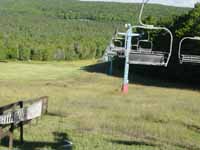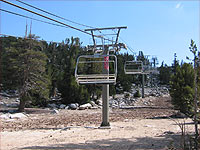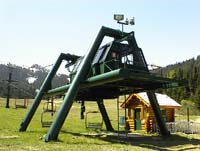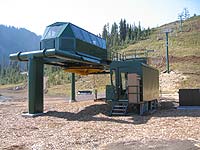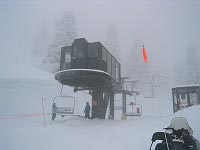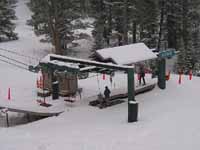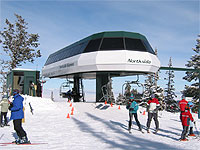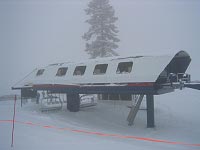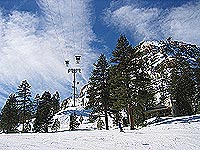Home : Chairlifts :
Facts & Features : Lift
ID Sheet : Doppelmayr CTEC
Doppelmayr
CTEC Identification sheet

There are two sides to Doppelmayr CTEC. The Dopplemayr side and
the Garaventa CTEC side. This first subsection shows current Doppelmayr
CTEC designs as well as past Doppelmayr designs.
| |
The DS Series Grip
(1985-1995)
This was one of Doppelmayr's first detachable grips. There
was another before it but it but it was retired in 1985, only
after a few years of service. The Doppelmayr Spring series
grip was replaced in 1995 by the Doppelmayr Torrsion Bar grip. |
| |
The DT Series Grip
(1995-Present)
The Doppelmayr Torsion Bar grip was first introduced in 1995
and was the replacement grip for the Doppelmayr Spring series.
This grip is still being used on new Doppelmayr/Garaventa
detachable lifts today. However, the grip has been banned
in a few European countries because of it is a double position
feature. |
| |
The Agamatic Grip
(N/A-Present)
Doppelmayr has taken over a number of companies in the past
and Agamatic was one of them. Agamatic was an Italian lift
manufacturer, but its detachable grips are still being used
by the Doppelmayr/Garaventa group today. The Agamatic detachable
grip made its first apperance in North America in 2003 and
it's the only other detachable grip offered by Doppelmayr
CTEC today. |
| |
The Center Support
Carrier
This carrier design was introduced by Doppelmayr in the early
1970s and retired in the 80s by the bail carrier design. |
| |
The 80s Style Carrier
This is the primary carrier style of the 80s. There
was also a version with a different hanger arm that was used
on the first detachable lifts. This carrier design was retired
in 1986. |
| |
EJ Carriers
(1985-Present)
This carrier was introduced in 1985 and is still available
by Doppelmayr CTEC on special request. However, the carrier
design is slowly starting to be phased out by Doppelmayr CTEC
and is being replaced by the new Garaventa carrier design.
Doppelmayr of Europe is still using this same carrier design,
but a slightly modified design. |
| |
The Garaventa Carrier
(1996-Present)
The Garaventa carrier design is now the standard carrier used
on all of Doppelmayr CTEC's new lifts and was actually an
optional carrier choice for Garaventa CTEC lifts prior to
the Doppelmayr and Garaventa CTEC merger. It's sad that Jan
Leonard of Doppelmayr CTEC had some say in the designing of
this carrier. |
| |
Terminals
A 1970s Doppelmayr terminal. |
| |
Terminals
This one is comprable to the terminal above but with
no cover. This model was used in the early 1980s. |
| |
Terminals
A 90s monopod drive. |
| |
Terminals
This one is the same as above but with a different motor room
design. Doppelmayr had multiple drive terminal designs. The
ones above are just examples. |
| |
A Fixed Return
Terminal
Here's an example of a Doppelmayr fixed hydraulic return terminal
looked liked. There are multiple variations of this. |
| |
Tension Return
Terminals
This is an example of an early 1980s tension return
terminal. |
| |
Terminals
The first detachable terminals were totally enclosed unlike
the newer kind. |
| |
CLD-260 Terminal
(1985-1989)
This was the first fully enclosed terminal design by
Doppelmayr and made its first apperance in about 1985. There
are some different variations of this terminal design, but
this model was the most previlant. |
| |
The UNI Terminal
(1989-1993)
This was the first generation of the UNI terminal. However,
this particular model only last for a few years before it
was replaced by a more innovative and improved terminal design. |
| |
The UNI Terminal
(1993-1994)
This UNI terminal design also had a short life span before
it was quickly replaced by one of Doppelmayr's most popular
terminals. |
| |
The UNI-M Terminal
(1995-2002)
There are a few different variations to this terminal but
it was first introduced in 1995 and was retired in 2002. The
picture on the left is of a version 1 UNI-M terminal. The
fallowing year in 1996, the huge windows were replaced by
smaller ones. |
| |
The UNI-M Terminal
(1995-2002)
The picture on the left is of a version 2 UNI-M terminal which
came out in 1996 and was retired in 1999. |
| |
The UNI-M Terminal
(1995-2002)
The picture on the left is of a version 3 UNI-M terminal which
introduced in 2000 and lasted until 2002 when Doppelmayr decided
only to offer the UNI-G terminal. |
| |
The UNI-M Terminal
(1995-2002)
This unique looking terminal on the left is actually the same
lift as in the above picture, except that the bottom terminal
has a built in maintenance bay. |
| |
The UNI-G Terminal
(2000-Present)
This is the current version of terminal used in Europe. It
has been discontinued by Doppelmayr CTEC but still can be
imported in from Europe for a little extra. Even though it
costs more, some of the bigger resorts prefer it. |
| |
The UNI-GS Terminal
(2003-Present)
This one was introduced when Doppelmayr and Garaventa
CTEC merged. While everything inside the UNI-GS, including
the structure and framework are from the UNI-G terminal, a
different kind of external skin has been used to make the
lift a little bit cheaper. |
| |
The UNI-GS Terminal
(2003-Present)
The easiest way to tell the difference between the UNI-G and
UNI-GS is the windows on the back of the terminal. |
| |
The Doppelmayr
Bullwheel
As you can see, the Doppelmayr bullwheel is different from
most others. It is like normal ones but the spokes are welded
together with sheet metal then holes are put in the sheet
metal. This bullwheel is an easy way to tell whether a lift
is a Doppelmayr or not but the design has been used by other
companies. |
| |
Sheaves
This one is agood example of Doppelmayr sheaves because
it has many of Doppelmayr's designs in it. The one on the
right is the most modern. New doppelmayr sheave trains also
have a red sheave or two in them. The red ones weigh more
and this is used as a derail detection device. |
CTEC / Garaventa CTEC


This section is all about CTEC designs. There are some Garaventa
ones in here too but CTEC was not changed much when they merged
with Garavnta.
| |
Grips
The CTEC fixed grip. This one may still be used on some fixed
grip lifts today. |
| |
The AK 400 Grip
(2001-Present)
A Garaventa design that was used on Garaventa CTEC lifts as
well as early Doppelmayr CTEC lifts. It had a short life span
in North America and was replaced by the Agamatic grip when
Doppelmayr purchased Garaventa. However, Doppelmayr/Garaventa
of Europe still use this grip on its MCS detachable lifts. |
| |
The AK 4 Grip
(N/A-2000)
In this picture, the CTEC grip can be seen. CTEC's carrier,
sheave, and tower designs can also be seen. |
| |
Carriers
This design is similar to the Doppelmayr center pole. It was
designed by Thiokol and CTEC continued to use the carrier
design after purchasing Thiokol's lift division. |
| |
Carriers
This one is also a Thiokol design. It was used when
CTEC was formed until CTEC came out with its own design. |
| |
Carriers
The carrier seen here is the design that replaced the above
one in the mid 80s. It can be said that it was a popular design
seeing as though it not only was installed on a number of
new CTEC lifts but it was also used to replace carriers of
other brands. It has been installed on new lifts until 2005
when it was discontinued. |
| |
Carriers
Seen here is the current chair design. It was used as an alternate
to the above carrier all throughout the Garaventa CTEC years.
|
| |
The Enterprise
Terminal
This one is another design that originated from the old Thiokol
company. In it's early years, It was totally covered with
a wooden cover. Since then, they have looked like this. They
have been discontinued but the exact year that they were discontinued
is unknown. |
| |
The Sprint Terminal
The Sprint is one of CTEC's original terminal designs and
is still in use today. |
| |
The Galaxy Terminal
The Galaxy is a similar design to the sprint but the
rails that the motor room sits on appear a bit beefier. The
motor room is the most distinct part of the galaxy. It appears
to be discontinued but there is one being installed in 2005. |
| |
Terminals
We are not sure of this ones name but it appears to be similar
to the Galaxy terminal but with a different motor room design. |
| |
The Gemini Terminal
A monopod CTEC terminal, the Gemini comes in many different
variations. The difference between them is usually what style
of motor room is used on the particular lift. |
| |
The UNI-Star Terminal
Seen here is the tensioned version of the gemini terminal.
This also an example of how the motor room design can vary.
The newest version of the Gemini has been given the name Uni-star
because it looks similar to the Uni-GS. |
| |
The Pegasus Terminal
This design can be described as the sprint terminal but without
the drive. This particular one has a roof which is not on
all pegasus terminals. This particular lift was originally
built by Riblet and was retrofitted by Garaventa CTEC with
this new terminal. |
| |
The Intrepid Terminal
A monopod terminal similar to the Orion but with tensioning. |
| |
The Orion Teerminal
The Orion is a simple return terminal. It is another Thiokol
design and is used on new lifts to this day. There are some
variations of it. |
| |
The Stealth Terminal
This was the first detachable terminal design that CTEC made
on its own. However, the lift does use Garaventa. |
| |
Terminals
CTEC does not have any truly old looking terminals because
they did not enter the detachable buisness until the 90s.
Their original detachable was built in a partnership with
Von Roll. |
| |
The Stealth 2 Terminal
This terminal designed was first introduced in 1996 when Garaventa
CTEC built its first detachable six-pack at Park City, UT.
The terminal was retired in 2000 when Garaventa CTEC released
its Stealth 3 terminal design. |
| |
The Stealth 3 Terminal
This Garaventa CTEC Design was used on new Doppelmayr CTEC
lifts until 2004 when it was discontinued in favor of the
UNI-GS. |
| |
The Funitel
Garaventa CTEC the only Funitel in North America (set aside
the QMC). It uses mostly Garaventa designs. It is located
at Squaw Valley. |
|






